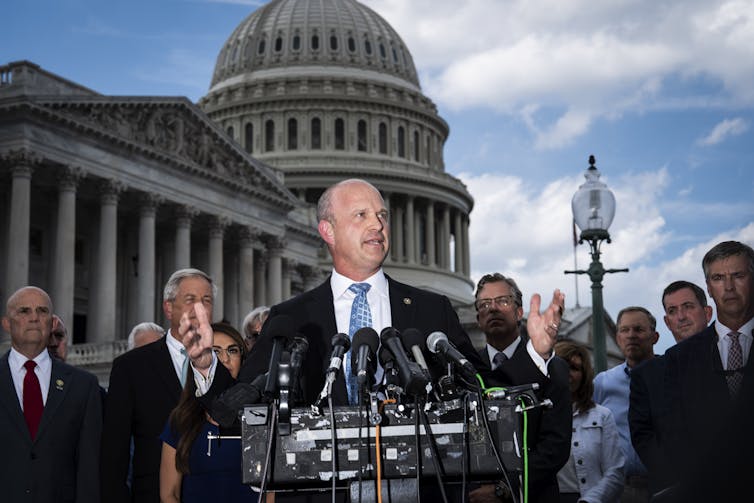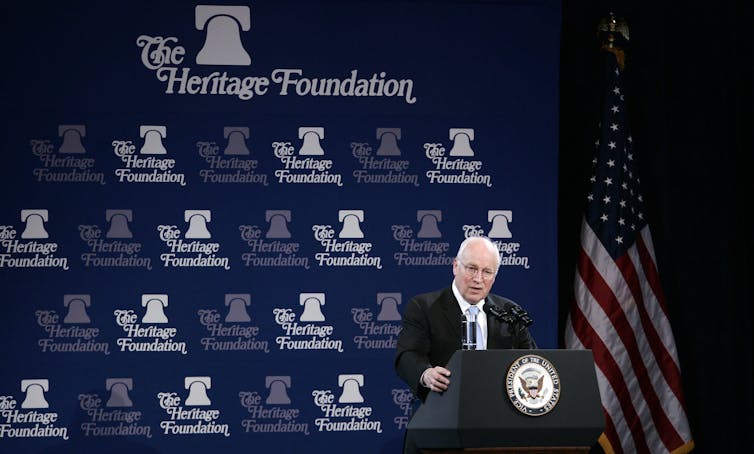Behind the Heritage Foundation's 50-year history of influencing GOP politics

As the 2024 presidential election heats up, some people are hearing about the Heritage Foundation for the first time. The conservative think tank has a new, ambitious and controversial policy plan, Project 2025, which calls for an overhaul of American public policy and government.
Project 2025 lays out many standard conservative ideas – like prioritizing energy production over environmental and climate-change concerns, and rejecting the idea of abortion as health care – along with some much more extreme ones, like criminalizing pornography. And it proposes to eliminate or restructure countless government agencies in line with conservative ideology.
While think tanks sometimes have the reputation of being stuffy academic institutions detached from day-to-day politics, Heritage is far different. By design, Heritage was founded to not only develop conservative policy ideas but also to advance them through direct political advocacy.
All think tanks are classified as 501(c)(3) tax-exempt organizations, which are prohibited from engaging in elections and can take part in only a small amount of political lobbying. But some, like Heritage, also form affiliated 501(c)(4) organizations that allow them to participate in campaigns and lobby extensively. Heritage is one of the sponsors of the Republican National Convention, which wraps up in Milwaukee on July 18, 2024.
In research for my forthcoming book, “Partisan Policy Networks,” I’ve found that a growing share of think tanks are explicitly ideological, aligned with a single political party, and engaged in direct policy advocacy.
Still, Heritage stands out from all of the groups I investigated. It is much more conservative and more closely aligned with former President Donald Trump’s style of Republicanism. Heritage is also more aggressive in its advocacy for conservative ideas, pairing campaign spending with lobbying and large-scale grassroots mobilization.
Americans should expect to hear a lot more about its ideas, like those outlined in Project 2025, if Trump is reelected in November 2024.
Kevin Roberts, president of the Heritage Foundation, speaks with members of the conservative House Freedom Caucus during a Capitol Hill news conference in September 2023.
Jabin Botsford/The Washington Post via Getty Images
A new type of think tank
Two Republican congressional staffers, Ed Feulner and Paul Weyrich, formed Heritage in 1973 as an explicit rebuke to existing think tanks that they thought were either too liberal or too meek in advancing conservative ideas.
Feulner and Weyrich were particularly incensed about how a preeminent conservative think tank at the time, the American Enterprise Institute, or AEI, timed its release of a policy report in 1971 on whether to approve government funding for supersonic transport airplanes, which can fly faster than the speed of sound. AEI published its recommendations several days after Congress voted on the issue, because it “didn’t want to try to affect the outcome of the vote.”
Heritage turns this philosophy on its head. Rather than producing policy research for its own sake, Heritage conducts research, as one employee told me in 2018, “to build a case, to make the argument for policy change.”
For example, Heritage’s affiliated 501(c)(4) advocacy organization, Heritage Action for America, and Sentinel Action Fund, a Super PAC it set up in 2022, spend money to influence elections and lobby elected officials on issues as diverse as taxation, abortion, immigration and the environment.
For this reason, some scholars and politicos call Heritage and other similar groups “do tanks” rather than “think tanks.”
Because Sentinel Action Fund is a Super PAC, it can raise and spend unlimited amounts of money to influence elections so long as they do not coordinate with candidate campaigns. Sentinel Action Fund then spent more than US$13 million on voter outreach and advertising in the 2022 midterm elections. The fund’s self-described aim was to ensure GOP majorities in the House and Senate by aiding “key conservative fighters” in “tough general elections.”
Former Vice President Dick Cheney addresses the Heritage Foundation in April 2007 in Chicago.
Jeff Haynes/AFP via Getty Images
People, not just money
But it’s the people, even more than money, that make Heritage influential, my research shows.
Heritage has directly worked to place former and current employees in congressional offices and the executive branch. More than 70 former and current Heritage staffers began working for the Trump administration by 2017 – and four current Heritage staffers were members of Trump’s cabinet in 2021.
Heritage also says that it has more than 2 million local, volunteer activists and roughly 20,000 “Sentinel activists” who receive information from Heritage and take part in organized campaigns to push for conservative policies. My interviews show that activists who partner with Heritage take part in strategy calls, contact elected representatives with coordinated messages and amplify the organization’s messaging on social media.
In one example from 2021, Heritage Foundation developed a report on election fraud and voter integrity. Heritage Action for America, meanwhile, coordinated volunteers to deliver this report to Georgia legislators, had staffers meet with these legislators to advise them on passing new voting restrictions, and paid for television advertising urging citizens to support such laws.
Heritage, Trump and Project 2025
All these efforts add up to a great deal of influence within the Republican Party. Heritage has played a key role in pushing Republicans toward more conservative policies since its creation.
When former President Ronald Reagan took office in 1981, for example, the Heritage Foundation had a ready-made conservative agenda for the new administration. By the end of his first term, Reagan executed more than 60% of the think tank’s policy recommendations.
When Trump took office in 2016, Heritage was again ready with friendly staffers and a handy policy agenda, called the Blueprint for Reorganization. By the end of Trump’s first year in office, Heritage boasted that he “had embraced 64 percent of our 321 recommendations,” among them key conservative priorities like tax reform, regulatory rollback and increased defense spending.
Project 2025 is similar to these other sets of recommendations for Republican politicians and presidential candidates. It outlines an agenda for a new president to adopt and a team of experts to help them.
But Project 2025 has taken on a different bent compared with earlier blueprints. Kevin Roberts, the president of Heritage, has described the group’s role as “institutionalizing Trumpism.”
This is probably why Project 2025, and Heritage, have received such an unusually large amount of attention in recent months. The fact that a wonky, 900-page policy memo has been the focus of countless news articles and hundreds of Biden campaign tweets, especially before the 2024 election, is a telling indication of its expected influence.
For its part, the Trump campaign has maintained distance from the project, as Trump himself has implausibly claimed that he knows nothing about it.
He is likely keeping his distance from Project 2025 because parts of the agenda are far too extreme for all but the most die-hard conservative activists. But even if Trump isn’t campaigning on these policies, Americans should expect Heritage ideas to matter greatly in a second Trump administration. The Heritage Foundation is built for this goal.![]()
Zachary Albert, Assistant Professor of Politics, Brandeis University
This article is republished from The Conversation under a Creative Commons license. Read the original article.


